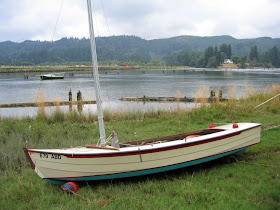
Among the vesicular watercourses belonging to the vestiges of primordial rainforest of the Great Pacific Basin, the Yaquina River retains much of its fundamental native beauty. Fifty miles long, and nearly thirty of them are tidal, thus navigable from the Pacific Ocean. Tall hardwoods hung with vines grow beside the conifers presiding over lush undergrowth along this terrestrial Eridanus.

Sourced in the Siuslaw National Forest on the western verge of the Willamette Valley, the Yaquina flows south, then generally west in a serpentine course, past Toledo, home port for SV Mistral. It melds with the Pacific Ocean in the Yaquina Bay, a broad estuary at Newport, Oregon.

A chilly fall morning may find intrepid fishermen sounding their way through the fog to prey on salmon or sturgeon, a practice inherited from the aboriginal inhabitants. Yaquina is a tribal name - people extinct now by the intrusion of aggressive settlers - but their presence can be felt on such a morning, so much that you might expect to see a silhouette digging for oysters or clams along the mud flats.
A loud protest and a lift of huge wings betrays our ghost to be a heron or a pelican who (rightly so) considers human presence invasive.

It’s still possible to ride the currents of the Yaquina with the rhythm of the tides. Rowers or paddlers will soon find themselves accompanied by a seal or sea lion. Not quite as primeval as Europeans found it, but a visitor can get a sense of a Stone Age rainforest fed by the waters of antiquity.

It’s the same water after all. We live in a closed hydroponic system, fed and watered by the same condensation rained down on millennia of denizens of the third planet from the sun.
With every country seeking to satisfy water needs from limited water resources, some see a future filled with conflict. But cooperation is the most effective response to trans-boundary water management issues.

We share responsibility for managing and protecting the world’s rivers for current and future generations. Despite pristine appearances, the Yaquina swings in disturbed balance, affected by human activities. The same fate defiles every drop of water on our little rock, from the Yaquina to the Etruria.

.....The water was like glass, no sound but the rhythm of oars as they dipped into the water like a metronome. Our only companion was a lone blue heron sitting on the bank watching us pass, a statue but for his swiveling head. The sun was slow to rise this close to the equinox, in the early morning fog, on the river...


Great post, Michael, with excellent points and homesickness-evoking photos of Oregon. I've read that some living Yaquina might yet be found on the Siletz Reservation.
ReplyDeleteRegards,
Michael H.
Michael,
ReplyDeleteIf you decide to move back to Oregon, please look me up!
The Siletz are a "nation" including all the tribes for miles and miles of Oregon coast. Our government "gave" this entire area to the indigenous people as a reservation, then took it back. I'm painfully aware that my beautiful home has been stolen from it's rightful inhabitants twice in recent memory. I left that part out of my post, it's too sad.